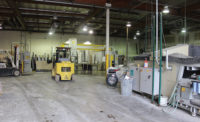Over the course of my writing over the past few months, I was obviously aware that the dollar was sliding in comparison to the Euro, but when you feel it in your own wallet, I suppose you notice it a bit more. In the interest of this column (written in mid-June 2003), I looked on the Internet to see what the "official" exchange rates were (as opposed to the "airport" exchange rates). As of this writing, the dollar had just declined 1% more against the Euro on June 13 alone -- reaching a rate of $1.1877 for 1 Euro. This is a little more than half a cent below May's record rate of $1.1932 for 1 Euro, but it is still a huge difference than even a few months ago. For comparison purposes, the posted exchange rate during the Marmomacc exhibition in October of 2002 was $0.9869 for 1 Euro -- over 20% more favorable than the current rate.
In simple layman's terms, economists state that the U.S. dollar's decline is the result of declines on Wall Street coupled with the war in Iraq. Even worse, it is declining at an even faster rate than some of the worst forecasts by economists. In March, for example, the rate was $1.10 for 1 Euro, and the prognosticators at Bear Stearns said that the rate would be at $1.15 by the end of the year (even considering the fact that the U.S. was on the brink of war at the time). Only two months later, the Euro has well exceeded that mark.
So how do members of the U.S. stone industry -- which relies greatly on Europe for stone materials, equipment and accessories -- combat this situation? Do you stop buying products that originate in Europe -- even if they are purchased through a U.S. distributor? Do you hold off on purchasing European products and wait for the rate to improve?
While there are no obvious solutions that fit the structure of all U.S. companies, curbing purchases from Europe is not necessarily the cure, and it is certainly not in the long-term interests of the industry. With many European and Far Eastern markets declining in terms of stone consumption, European producers of stone and related products are looking to the U.S. market more than ever before. Moreover, as American stone use per capita continues to rise, we are not just of passing interest to European producers. They want to create long-term relationships with U.S. companies, and they are actively seeking these relationships around the country.
With this in mind, now is the time for U.S. producers to ask European producers to "partner" with them. Try to get creative with the pricing to compensate for the decline in the dollar value; perhaps even ask for discounts before turning elsewhere or putting off purchases altogether. Many companies may be trying this anyway, but U.S. consumers of stone and related products should know their enhanced status in the international market. This has an intrinsic value that may help offset the fluctuations in currency.
In short, perhaps U.S. consumers have to think more about purchasing European products, but they should make prudent purchases and keep the industry going. Despite incredible growth in the U.S. stone industry, we still face stiff competition from Corian and other manmade products, and hoarding our money to wait for better times is not the answer.



